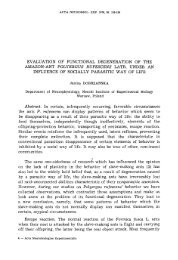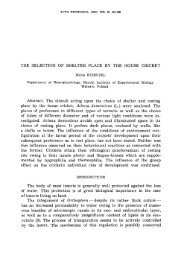Robert W. Doty (1920–2011) - Acta Neurobiologiae Experimentalis
Robert W. Doty (1920–2011) - Acta Neurobiologiae Experimentalis
Robert W. Doty (1920–2011) - Acta Neurobiologiae Experimentalis
You also want an ePaper? Increase the reach of your titles
YUMPU automatically turns print PDFs into web optimized ePapers that Google loves.
xvi Obituary – R.W. <strong>Doty</strong><br />
brain of macaques. His team discovered very unusual brain neurons, known as luxotonic cells that are sensitive<br />
to a wide range of light levels, from near darkness to extreme brightness. Recently, scientists have taken a renewed<br />
interest in these cells and a previously unknown brain circuit has been discovered that is involved in regulating<br />
the eye’s pupil size and the body’s circadian rhythm. Long-time collaboration of Prof. <strong>Doty</strong> with Prof Żernicki<br />
from the Nencki Institute concerned investigation of the interplay of midbrain and cortex in maintaining the state<br />
of consciousness (1970) and of the interhemispheric transfer of information required for habituation (1997). Later,<br />
Nencki post-docs had the great opportunity to expand their knowledge and skills in his laboratory.<br />
Prof. <strong>Doty</strong> was one of the key people in the team that in 1969 created the Society for Neuroscience that now<br />
has more than 40,000 members and in 1975-1976 he served as its president. He participated in almost all yearly<br />
Meetings of the Society, always driving there by car. Prof. <strong>Doty</strong> was also a fellow of the American Physiological<br />
Association, the American Psychological Association, the American Association for the Advancement of<br />
Science, International Brain Research Organization, American Society of Primatologists, the American Society<br />
for Advancement of Science and the Japan Society for Promotion of Science. He served also as a visiting professor<br />
at the University of Mexico and Osaka University in Japan.<br />
In 1996 <strong>Doty</strong> retired, continuing as part-time Professor Emeritus in the Department of Neurobiology and<br />
Anatomy, University of Rochester Medical Center. He was very devoted to his research and kept his laboratory<br />
going long after retirement, frequently buying equipment and supplies with his own money. He also donated<br />
funds and guidance to create an annual lectureship on “Consciousness from neurons” in the name of his wife,<br />
Elizabeth Jusewich-<strong>Doty</strong>, who died in 1999. To honor her memory and their marriage, he also compiled, wrote<br />
and self-published a book “Man and woman, war and peace, 1941-1951: A dual autobiography verbatim from<br />
their letters and diary” based on letters they had exchanged during his World War II Army service and Elizabeth’s<br />
detailed diary which she kept throughout their married life.<br />
Throughout his career Prof <strong>Doty</strong> frequently acknowledged contributions of thinkers and scientists that were<br />
first to propose various scientific ideas, like Alkmaion, who first put forward the idea that our thoughts are a<br />
functioning of the brain, and of neuroscientists from Eastern Europe, like Pavlov, Bekhterev, Beritashvili or<br />
Konorski whose contributions are frequently overlooked. With accumulating scientific experience, <strong>Doty</strong> was<br />
also reflecting on the inadequacy of our ideas describing immensely complex brain phenomena. Results of his<br />
experiments of conditioning with paired electrical stimulation of different parts of the cerebral cortex, which<br />
drew on Pavlov’s and his pupil Pyotr Kupalov’s ideas and were conducted with another Pavlov’s pupil, Cornel<br />
Giurgea, led him to formulate broader ideas about reality of our cognition of the world and internal production<br />
of brain images (“butterflies in the brain”). Results of <strong>Doty</strong>’s experiments are helping now in building prostheses<br />
of the visual system and his reflections on these results help bridge neuroscience and philosophy.<br />
In spite of his own and his family’s health problems in the last years, Prof. <strong>Doty</strong> maintained curiousity,<br />
thoughtfulness and a positive attitude to the very end of his life. He is survived by his four children and two<br />
great-grandchildren and predeceased by his wife and granddaughter. His body was donated to the Anatomical<br />
Gift Program at the University of Rochester Medical Center. Thus, there was no funeral service in January 2011,<br />
but a memorial service was held on June 26, 2011. Many people all over the world will remember him and are<br />
going to miss the yearly “<strong>Doty</strong> Doings”, fascinating accounts of his experiences and thinking that he had been<br />
sending faithfully to friends all over the world.<br />
Selected bibliography of Prof. <strong>Robert</strong> W. <strong>Doty</strong><br />
Anna Nowicka<br />
Kris Turlejski<br />
Anonymous. Fifth army at the winter line (15 November 1943-15 January 1944) (1945) Washington, DC: Historical<br />
Division, U.S. War Department, U.S. Government Printing Office, Superintendent of Documents.<br />
<strong>Doty</strong> RW, Gerard RW (1950) Nerve conduction without increased oxygen consumption: Action of azide and fluoroacetate.<br />
Am J Physiol 162: 458–468.









